How to Build AI Software: Step-by-step Guide
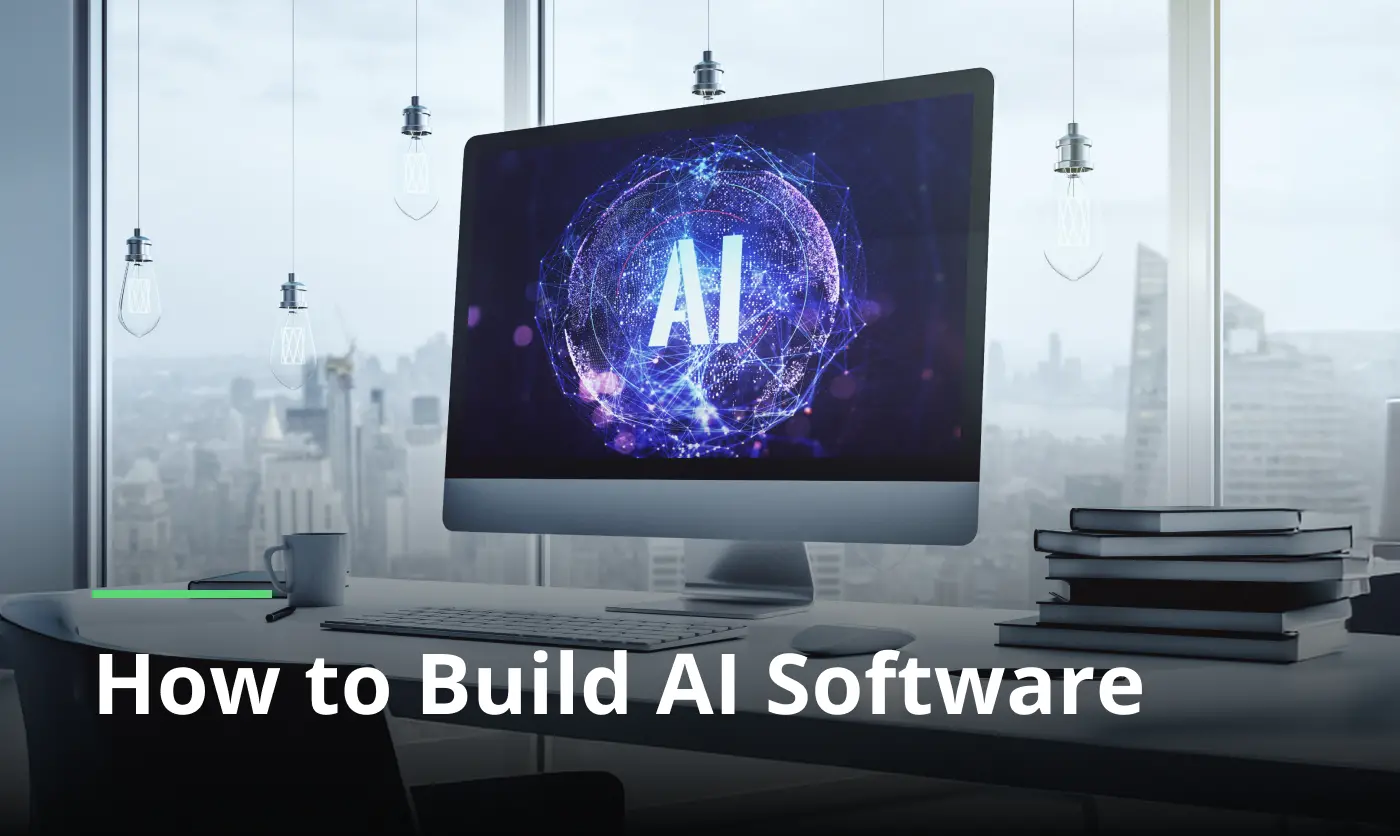
AI software development is not a thing of dreams or a distant reality anymore, and businesses are already catching up to leverage this technology to improve operations. Today, we are going to outline the fundamental aspects you need to know to create a solution for your needs.
Partnering with a custom software development company in the UK can help you get tailored, high-performance solutions that match your goals. Today, we are going to outline the fundamental aspects you need to know to create a solution for your needs.
To build AI software that works wonders, you will need to get a firm handle on the right tech stack and clear the hurdles that come your way. Along the way, we will break down key features and pricing, and help you choose the best-suited services supplier.
Our battle-tested pros in artificial intelligence software development are going to peel back the layers and give you a comprehensive synopsis of this subject. If you are aiming to build something groundbreaking, Limeup AI offerings are your passport to smarter results. We’ll begin from the ground up and highlight what makes a reputable provider tick.
What is artificial intelligence software?
The technology behind artificial intelligence exists in the present era as it drives current industry transformations and daily operational innovation. Pioneering groundbreaking advancements, AI software development companies fuel the relentless march of automation, empowering machines to think, adapt, and operate with unprecedented autonomy.
The core concept of such software creates artificial intelligence through machine ingenuity to think just like humans while learning and deciding autonomously past human abilities. Community-wide AI platforms function behind the scenes of application interfaces, enabling users to interact with Siri and Alexa while facilitating self-driving technology and revolutionizing healthcare automation.
But what makes AI software development services tick? It’s all about algorithms. The secret sauce of machines enables them to learn from data while adapting to new situations and engineering better performance throughout time. Notably, Microsoft has announced an additional investment of approximately $296.81 million in intelligent infrastructure within South Africa, underscoring the global commitment to enhancing cognitive processing power.f
Neutral computer power extends its reach as far as users wish to go. AI technology in healthcare delivers disease diagnoses that match many years of professional medical expertise. The ability to detect financial fraud runs at times beyond human potential within finance systems.
Thanks to AI software development solutions marketing has achieved breakthroughs in customer experiences by offering precise recommendations to individual users. The huge number of potential uses shows no sign of slowing down.
AI’s integration into our world creates a cumulative effect on its potentials, which increase substantially. Future preparedness rests on your ability to welcome digital cognition into your life as a partner. Organizations that fail to integrate smart computing into their operations will witness major competition gaps because the leadership already runs with AI.
What is AI software development?
Artificial intelligence has taken a major stance in the global market, offering new opportunities for businesses and consumers in all kinds of sectors and industries. The vast expansion and introduction of this technology are pushing more corporations to tap into the endless potential of this technology. But what exactly does it mean?
Unlike traditional software that is conditioned to follow specific instructions that programmers set, when you create artificial intelligence software you train the model to respond to certain prompts and conditions based on the data it acquired. By learning the patterns of the information, it is adept at generating original outputs and solving many operational issues of businesses.
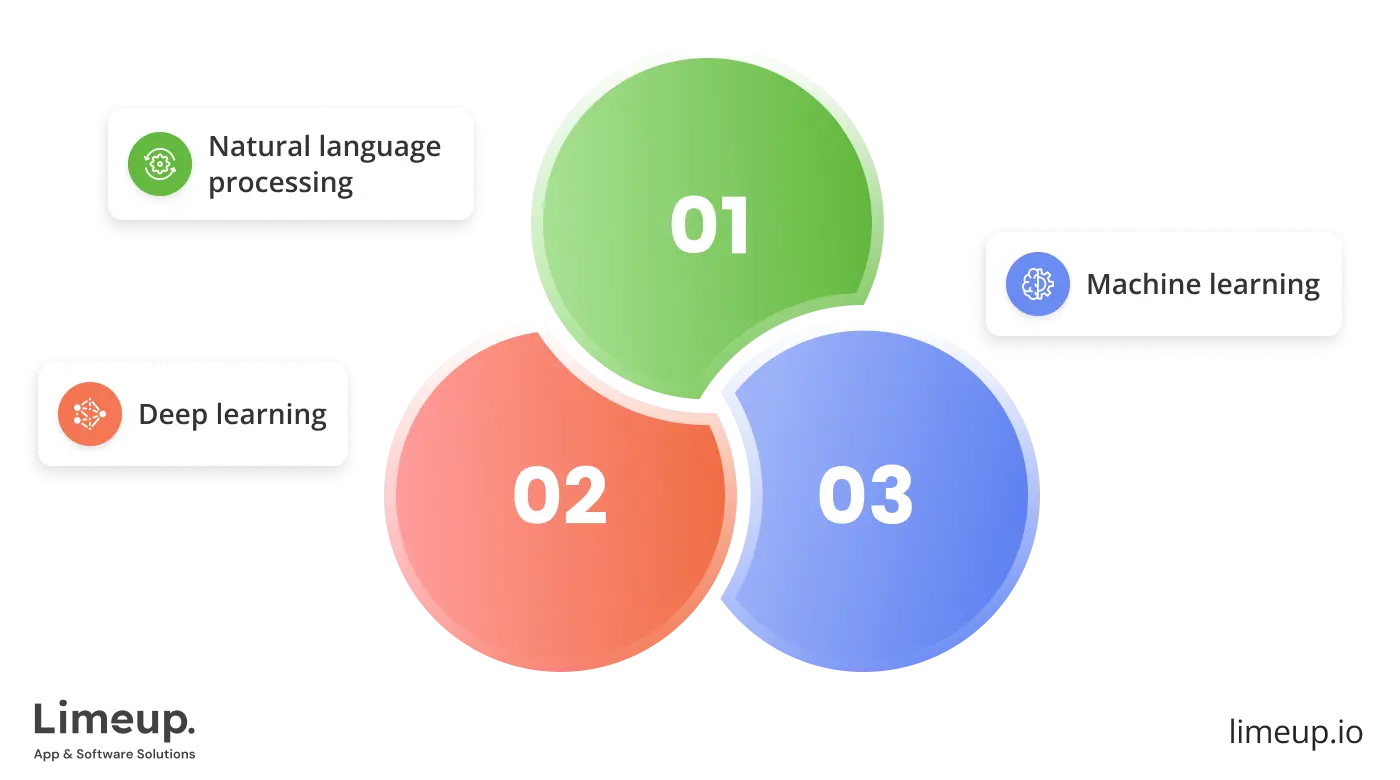
At the core of software AI are several components such as machine learning which is the most widespread type trained to make predictions and answer questions. Another one is called deep learning which is a more advanced version capable of producing high-resolution images and high-quality audio based on technology known as neural networks.
One type of model that is rapidly gaining traction is natural language processing and it is able to process natural human language for purposes like chatbots, translations, voice recognition and more.
There are many areas in which you can develop AI software, for example, the financial technology sector is looking into finance advisors leveraging the predictive analytics acumen of such platforms. But don’t just take our word for it; Forbes reports that 43% of consumers are planning to utilize artificial intelligence to answer financial questions.
The speed at which this innovative approach to running operations evolves necessitates that companies find reliable and qualified engineers to handle the creation of sophisticated algorithms on which the software is based. Since the progression of this tech is by leaps and bounds, continuous improvement and monitoring are essential to keeping the final solution up-to-date and accurate.
However, one key consideration regarding how to make AI software lies in the ethical concerns both users and providers face when taking on such projects. These are in consideration for user privacy, security, and fairness of the outputs generated by the system.
The legal bodies that regulate artificial intelligence production are quickly catching on, identifying the main causes of issues and establishing standards for construction. We will touch more on this subject later in our overview, but for now let’s explore how such software is created in the first place.
How to create AI software in five steps?
The process of crafting an artificial intelligence model from the ground up differs quite significantly from regular software creation and it can be complicated to wrap your head around some complex processes. This is why having a knowledgeable team by your side is of such importance to the overall success of the project.
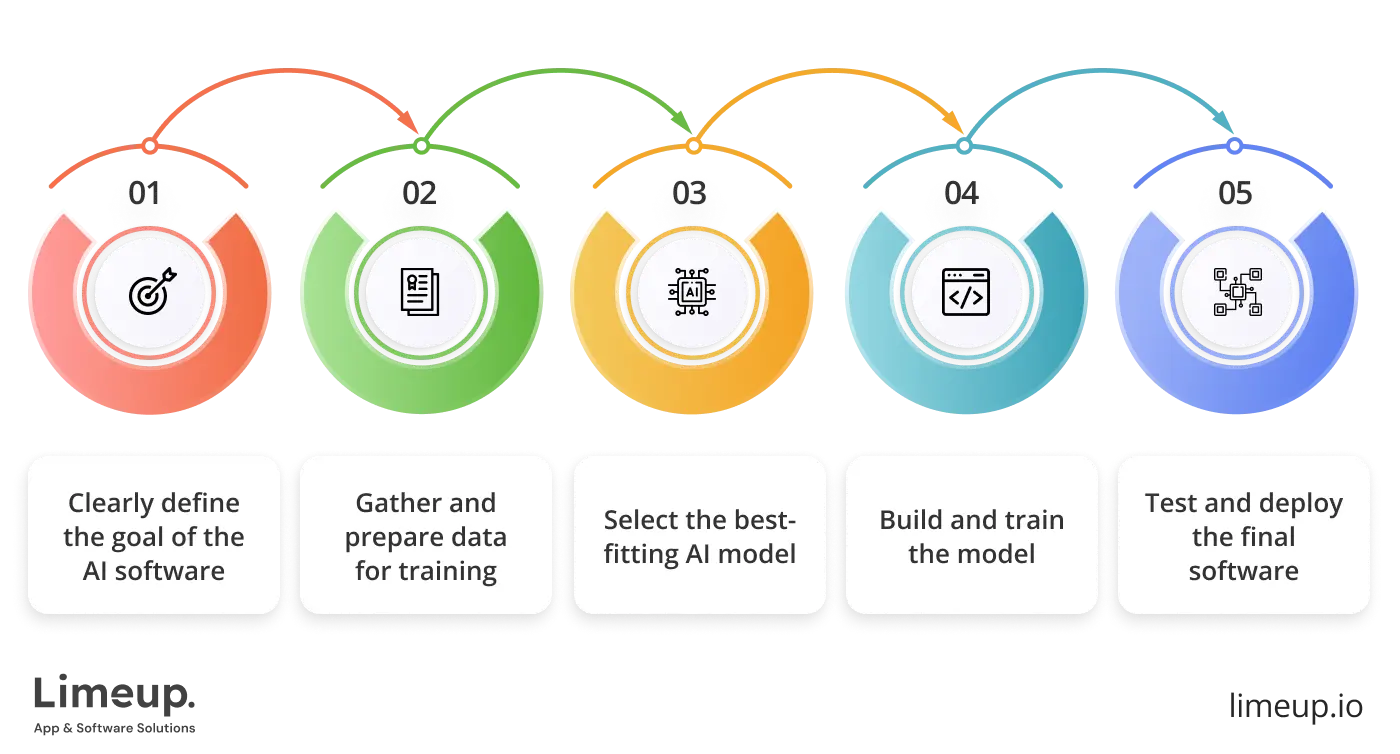
Still, we want to give you a general understanding of the steps you need to take to make AI software in order to keep you informed at every stage of the way. Let’s break it down into five primary phases.
- Clearly define the goal of the AI software.
While this step may seem trivial and you encounter it in every synopsis on the development matter, in reality it plays a pivotal role and lays the foundation for the entire software. Think of it this way: how can you make any initiative successful if you fail to grasp its purpose and goals, let alone make any tangible impact on business processes?
Your duty lies in clearly defining why you need the AI software in the first place, for example, for optimizing insights, predicting outcomes or improving customer service. Only then can you proceed to other building blocks of the software and make the proper decisions to hit your objectives.
- Gather and prepare data for training.
The metrics you “feed” to the model are going to determine how good it will be in generating outputs and whether they will be accurate and relevant. If you want to know how to develop AI software, you need to collect structured and unstructured info, with the former being well-organized information like spreadsheets and the latter being natural language if that is what you aim for.
Figures you have collected needs to be further cleaned up and prepared for the training, meaning inaccurate or irrelevant information has to go. This process can take quite some time but it ultimately keeps your software away from skewing the results.
- Select the best-fitting AI model.
Depending on the tasks you set out before the setup for the general purpose of your AI tech, you and your team are now going to agree on the type of model that will suit those needs the best. It is highly important as there are several different models, each responsible for handling unique kinds of tasks.
For instance, you can choose from Machine Learning (ML), Natural Language Processing (NLP), Convolutional Neural Networks (CNN) and much more. This will determine if your software is capable of generating text, images, code and so on.
- Build and train the model.
Now the most critical part comes your way — building AI software. This stage requires a deep understanding of the technology and skills in data science to make sure the results meet your expectations. The tech gurus at this stage will select the optimal technology stack and tools to use, which we will discuss in detail in our next section.
In simple words, the training process looks like this: the input that you have gathered is now fed to the model using specific parameters like learning rate to avoid output errors. It is then validated through various methods to fine-tune how the model responds to prompts.
- Test and deploy the final software.
Evaluation of the AI software is unskippable as it confirms the final version works as intended and engineers employ a variety of test sets to assess metrics like accuracy, speed, etc. If errors are identified, retraining may be necessary, which can take up extra time for iterations but it’s also completely natural.
Once every stage up until now is complete, the coders will deploy the solution to the production environment and integrate it with your system, whether it is an application, web app or enterprise software. After that, your duty will lie in consistently monitoring the performance and introducing adjustments as needed.
Key features of artificial intelligence software development
The ultimate goal of building software with AI is to engineer machines capable of learning on their own, fine-tuning their actions as they predict future outcomes and operate independently, free from constant human guidance. What puts visionary cognitive computing ahead of standard automation? The intelligent systems revolution depends on its defining features which we will examine now.

- ML, brainpower behind AI.
Artificial intelligence software development thrives on the synergy between metrics and learning algorithms. Within the realm of AI, machine learning serves as the driving force, enabling it to adapt and grow by harnessing vast records collections. By identifying recurring trends and learning from past actions, AI refines its skill set, making increasingly smarter decisions that improve its overall performance.
Google search engine executes billions of queries each day by modifying its search results to match users’ browsing patterns. The quantity of processed figures directly affects the precision of insights just as a chess expert predicts game moves.
- NLP — teaching AI to speak human
AI’s ability to function effectively is rooted in its capacity to decipher every layer of human communication, from verbal exchanges to the cultural subtleties embedded within them. Understanding these nuances ensures AI may connect with humans on a deeper level. The artificial intelligence capability to handle text and speech analysis comes from Natural Language Processing tactics.
The power behind voice assistant services and customer service bots as well as translation tools stems from this feature, which allows them to deliver natural responses.
- Computer vision, AI’s window to the world.
Artificial intelligence has transcended its previous boundaries which included just numbers and text. The automated comprehension of images and videos through computer vision serves as industry base for healthcare organizations as well as security measures and autonomous vehicle systems.
Like digital alchemists, AI software developers transform raw algorithms into powerful innovations that redefine the limits of machine-driven intelligence. Medical intelligent programs demonstrate better diagnostic abilities than physicians do in X-ray analysis while self-driving cars employ road condition examinations for safe operation.
- Predictive analytics, tomorrow’s insights today.
AI becomes an insightful fortune teller, forecasting trends and outcomes well before they hit the radar. Enterprises embracing this avant-garde prowess may thwart fraud before it gains a foothold, anticipate market fluctuations with razor-sharp precision, and outmaneuver unforeseen machinery failures before they spiral into financial sinkholes.
Such shifts allow companies to move from reactive to proactive, using data-driven predictions to make informed decisions that keep them ahead of the curve.
- Autonomous decision-making — when AI takes the wheel.
In an instant, autonomous artificial intelligence steps in, making rapid decisions and executing adjustments all on its own, bypassing human involvement entirely. Market analysis from financial trading bots enables immediate and automatic trading activities which deliver superior returns above conventional investment methodologies.
The savvy AI behind logistics operations reads traffic patterns on the fly, redirecting deliveries to bypass bottlenecks and save time. The initiative-taking functionality of such tech drives operational change at all levels of various industries.
How to choose the right tech stack for developing AI software?
Making the soundest decision in terms of a tech stack for AI software creation requires a team of engineers that is well-versed in this kind of programming. Since it is quite a complicated science, a small mistake may cost you the viability of your model.
The tools, languages, technologies you choose for the training and production are going to affect the programming timeline as well as the price tag to hire AI developers. So, how do specialists pick the stack?
Artificial intelligence software developers largely base their decisions on the goals of the solution, its complexity and scalability needs. Another factor that plays a role is the maintenance and support options you will have in the long run since such software necessitates careful monitoring.
Let’s take a closer look at the key components that make up the technology stack and some of the options available in each part.
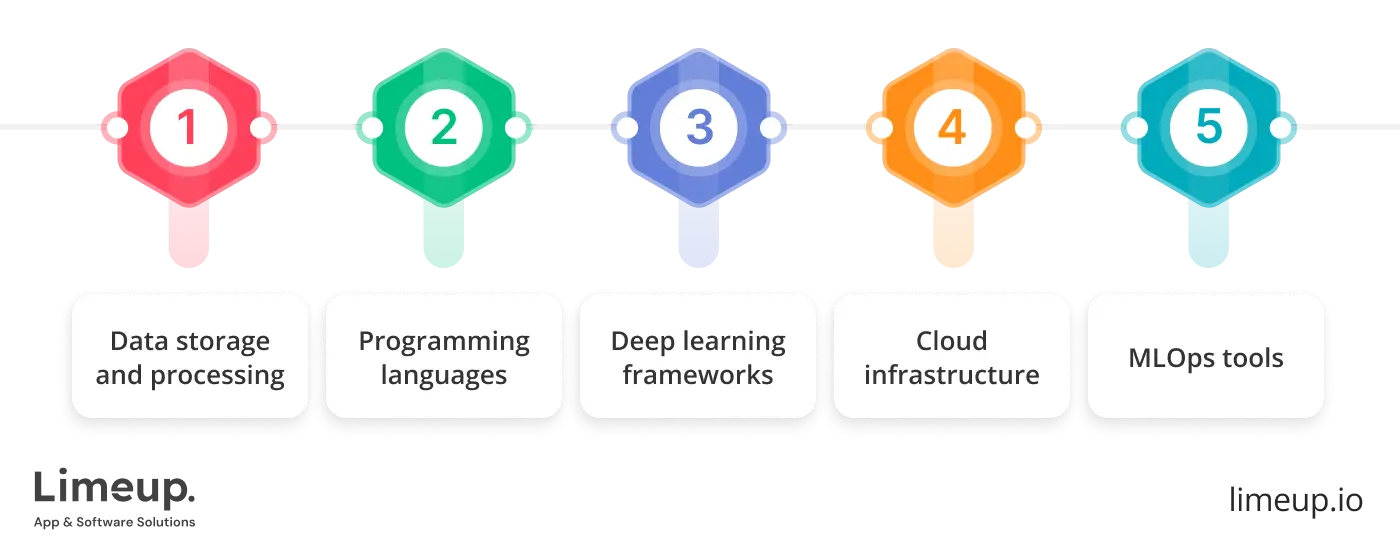
Data storage and processing. Savants typically choose SQL databases like MySQL or PostgreSQL for structured statistics as they offer the necessary functionality and are a traditional go-to option. For unstructured content, NoSQL options such as MongoDB are normally opted for.
When it comes to real-time input processing, tools like Apache Spark and Hadoop are generally considered.
Programming languages. The codebase you will find the most regarded for artificial intelligence software is Python. Why? For starters, it is a highly readable syntax that any artificial intelligence software developer can understand, as it resembles natural speech. Numerous dedicated libraries and frameworks are available to support this particular setup.
Aside from Python, R is often used for tasks related to stats visualization, and Java is making strides in the industry due to its suitability for large-scale AI applications. In addition, C++ is often the choice for strategies that require high performance.
Deep learning frameworks. In order to build and train neural networks, the team is going to need robust frameworks that can handle large amounts of info. A leading pick for this purpose is TensorFlow, introduced by Google in 2015, revered for its wide-ranging versatility in shaping AI models.
Additionally, Keras is integrated into the TensorFlow library which makes it an ideal duo for streamlining the deep learning process. PyTorch is another popular option used in handling natural language processing as well as dynamic computation.
Cloud infrastructure. Leveraging cloud platforms in software development for AI is essential to keeping maintenance costs at a low and optimizing the deployment and support practices. Without the hassle of on-premises setups, engineering specialists can dedicate more time to pivotal aspects of the project, like model training, rather than worrying about infrastructure.
Some of the go-to options for cloud platforms are Amazon Web Services (AWS) since they offer a lot of opportunities for AI creation, Google Cloud Platform (GCP) which supports TensorFlow, and Microsoft Azure which provides competency for building, training and deploying models.
MLOps tools. Machine Learning Operations, commonly known as MLOps, are an integral part of streamlining and automating processes related to artificial intelligence production. This set of tools and practices is capable of addressing the unique challenges when you create AI software that regular DevOps does not.
Notable options include MLflow for handling the entire lifecycle, Docker for automating parts of the workflow, and Kubeflow for driving continuous integration and deployment.
To learn more about the criteria to select your perfect match, take a look at material where our team discussed comparison of software development companies in London to help in making the right choice.
Price of software development for artificial intelligence
When plunging into the intricate world of artificial intelligence creation, the burning question that surfaces first is: how much will it cost? To put it plainly, the financial outlay for crafting AI-powered apps is as unpredictable as a stormy sea, swayed by countless variables that send fees soaring or dipping. It’s not a one-size-fits-all answer, and just like the old adage goes, “You get what you pay for.”
Let’s lay the groundwork. The price tag of crafting AI-driven applications hinges largely on the intricacy of the undertaking, the breadth of the envisioned resolution, and the caliber of masters steering the project.
Serious AI apps with basic functions need investments from $10,000 to $50,000 yet sophisticated enterprise products will typically charge between $100,000 to $1 million. An examination of the price factors will put your fears to rest.
Once the custom AI software development phase wraps up, the financial burden doesn’t hit the brakes — it accelerates. Intelligent methods demand ongoing attention, with upkeep woven into their operational lifespan. The investment in skilled engineers remains a heavyweight expense, keeping the wheels of innovation turning long after the initial build.
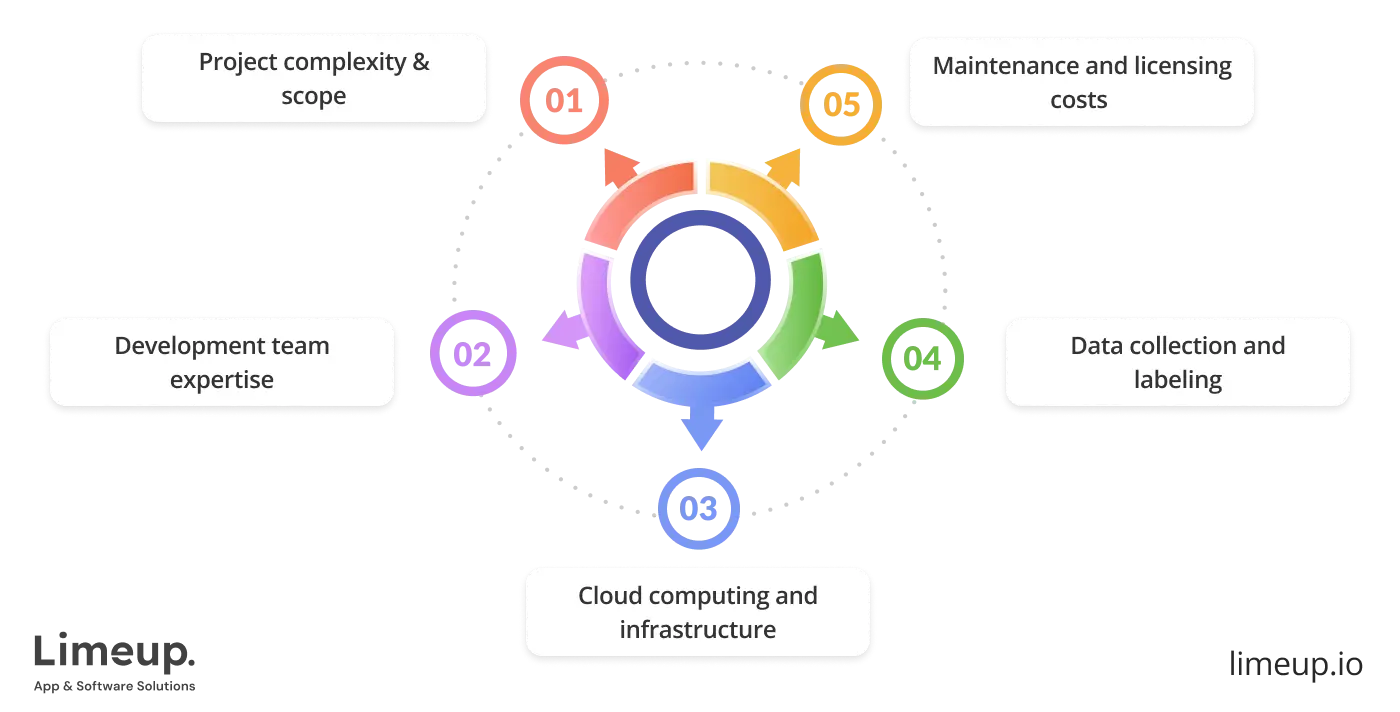
The annual compensation for top-level programmers reaches prices higher than $100,000. Powering AI tools through cloud computing services such as AWS or Google Cloud raises fees to above $10,000 every month. Numerous expenses accompany machine learning information collection and labeling activities because extensive datasets require significant investment.
The road to AI advancement requires companies to recognize that developing technologies is a unique, singular undertaking. Over 65% of the total software lifecycle cost is devoured by maintenance activities, a significant portion that often goes unnoticed. The expenses related to tool, library, framework licensing run yearly fees that range from $1,000 to $50,000.
To demystify these figures, we’ve split them into a comprehensive table that outlines the distinct components and features involved in AI software engineering. This chart provides more nuanced perspective on where expenditures arise, offering clarity and shedding light on the various moving parts that contribute to the overall price of building AI architectures.
| Component | Description | Estimated cost |
| Basic AI mechanisms | AI tools designed for specific tasks like customer service automation or basic predictive analytics. | $10,000 — $50,000 |
| Advanced AI solutions | Multi-functional AI that handles complex tasks like decision-making, real-time data processing. | $100,000 — $500,000 |
| Enterprise-grade AI | Large-scale AI applications requiring multi-layered functionality and large datasets. | $500,000 — $1,000,000+ |
| AI developer salary | Salary of a highly skilled AI engineer with expertise in machine learning, data science, etc. | $100,000+ annually |
| Cloud computing & infrastructure | Cloud services (AWS, Google Cloud, etc.) for hosting, storage, and computing power for AI models. | $10,000+ per month |
| Data collection & labeling | Gathering and labeling data for training AI models (can be extensive and time-consuming). | $5,000 — $100,000 (depends on dataset size) |
| AI maintenance & updates | Ongoing updates, model retraining, and infrastructure maintenance. | 15-20% of initial cost per year |
| AI frameworks & tools | Out-of-pocket expenses for AI frameworks, tools, library subscriptions. | $1,000 — $50,000 per year |
This table underscores the various elements at play in creating AI software, giving you a bird’s-eye view of what drives the costs in this space. So, when calculating the potential investment for AI, it’s crucial to consider the depth of functionality and ongoing support required to maximize the software’s potential.
How to select an AI software development company?
Your AI software evolution largely depends on finding the most suitable builders. Getting a clear strategy allows you to steer clear of wrong turns which leads to finding someone who shares your future goals. Your decision-making process for selecting the fitting firm should consist of the following steps:
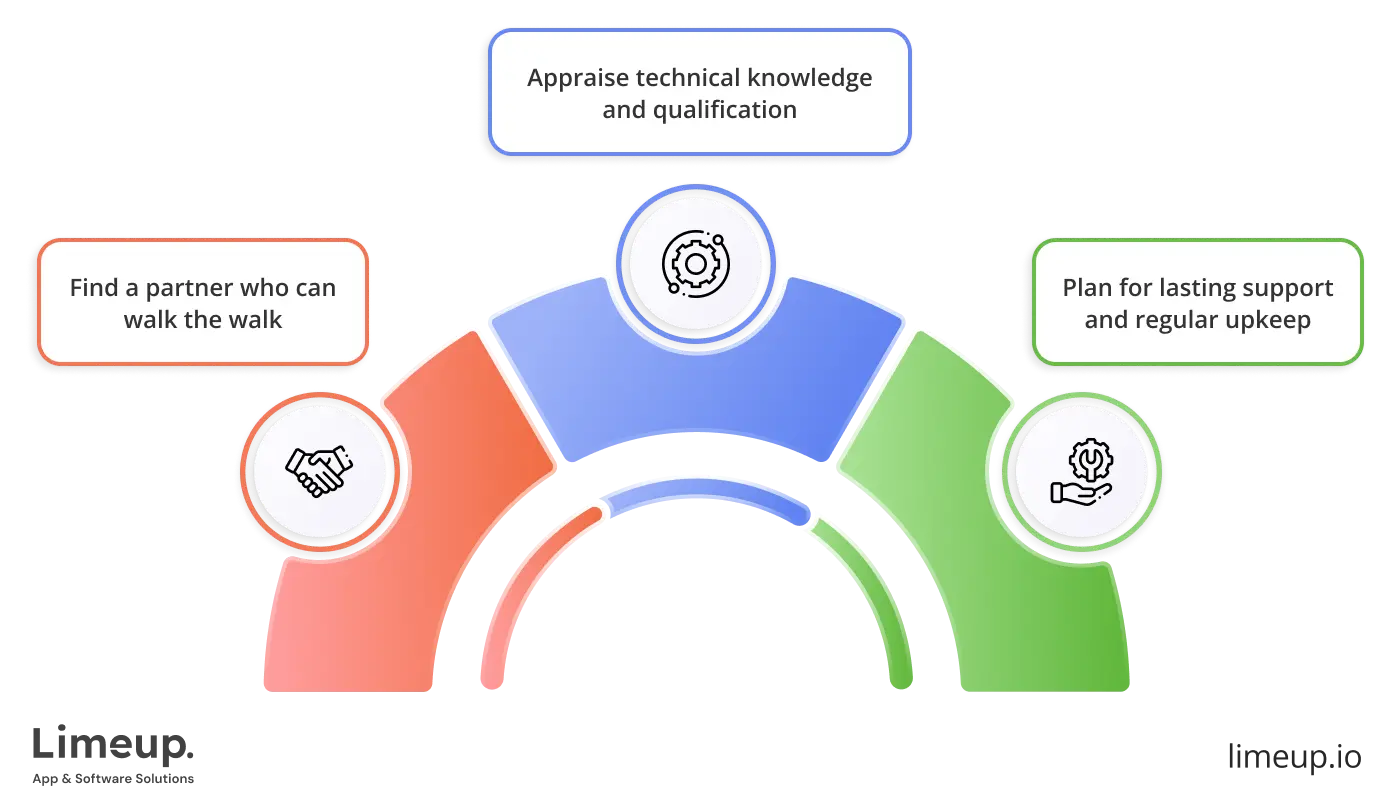
- Find a partner who can walk the walk
Why it matters: AI initiatives succeed through the knowledge gained from past endeavors. Artificial intelligence software development company that demonstrates extensive know-how through its diverse portfolio becomes capable of tackling advanced problems along with implementing new technology and creating advancements.
Choosing a trusted AI software development company in the UK ensures that your project benefits from industry best practices, cutting-edge tools, and a team capable of delivering high-quality, scalable solutions.
What to look for: check how the vendor executed previous projects that targeted AI systems comparable to yours. The agency that has previously succeeded within your sector and AI specialization field will offer superior aptitude to fulfill your business requirements.
Tip: “Don’t reinvent the wheel.” Every experienced studio delivers ready ideas that benefit your operations.
- Appraise technical knowledge and qualification
Why it matters: technical proficiency levels throughout AI projects are essential for both artificial intelligence algorithms and natural language processing methods.
What to look for: your search criteria must include the AI-concentrated technology suite of the potential vendor along with team proficiency and the range of knowledge related to your field of AI technology requirements.
Tip: the actual problems exist within the small components. Look for a studio stressing deep industry knowledge as general familiarity will not yield satisfactory results.
- Plan for lasting support and regular upkeep
Why it matters: the creation of AI app consists of ongoing monitoring as well as refinement through continuous updates which establish its importance for sustained success. Reliable AI software development service incorporates continued backing and maintenance for their clients.
What to look for: focus on companies who display a specific timeline for sustaining the application following its release alongside strategies for smart technology enhancement as technologies advance.
Tip: it’s not just about getting it done, it’s about keeping it running. Choose a partner who’s committed to the long haul.
Final thoughts
There is no denying that the future of software technologies lies in understanding the purpose and implementing artificial intelligence to streamline and automate certain parts of business operations. Although its widespread adoption is still around the corner, you can already use artificial intelligence software development services to solve your and your customer’s pain points.
It would also be unfair to overlook the complex challenges that engineers face during production, but with the well-crafted approach, there is no mountain you can’t climb. By familiarizing yourself with the ins and outs of this multilayered matter, you can safely navigate it and reap endless benefits with an unyielding method.
Within our brief, you have learned how to create your own AI software, what tools and technologies are behind it, how security is ensured and much more to be armed to the teeth with knowledge.
If you are looking for savvy AI provider, be sure to contact Limeup. Our professionals are always ready to lend a helping hand with the creation of your unique software.

